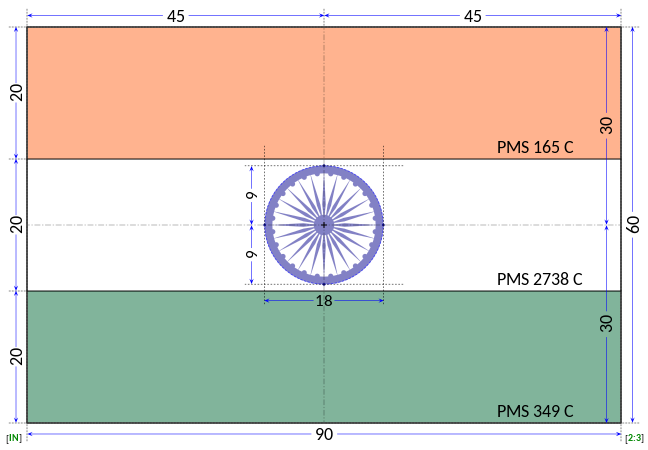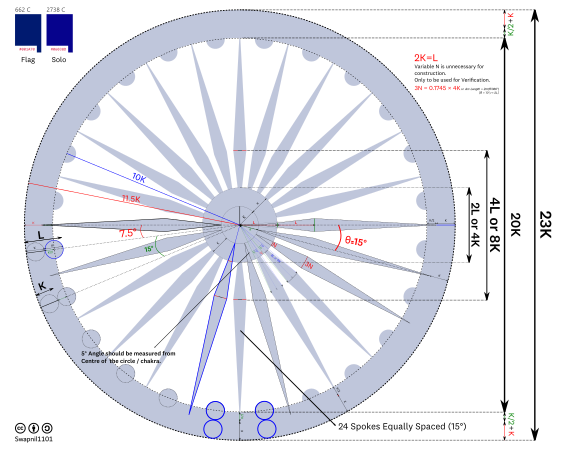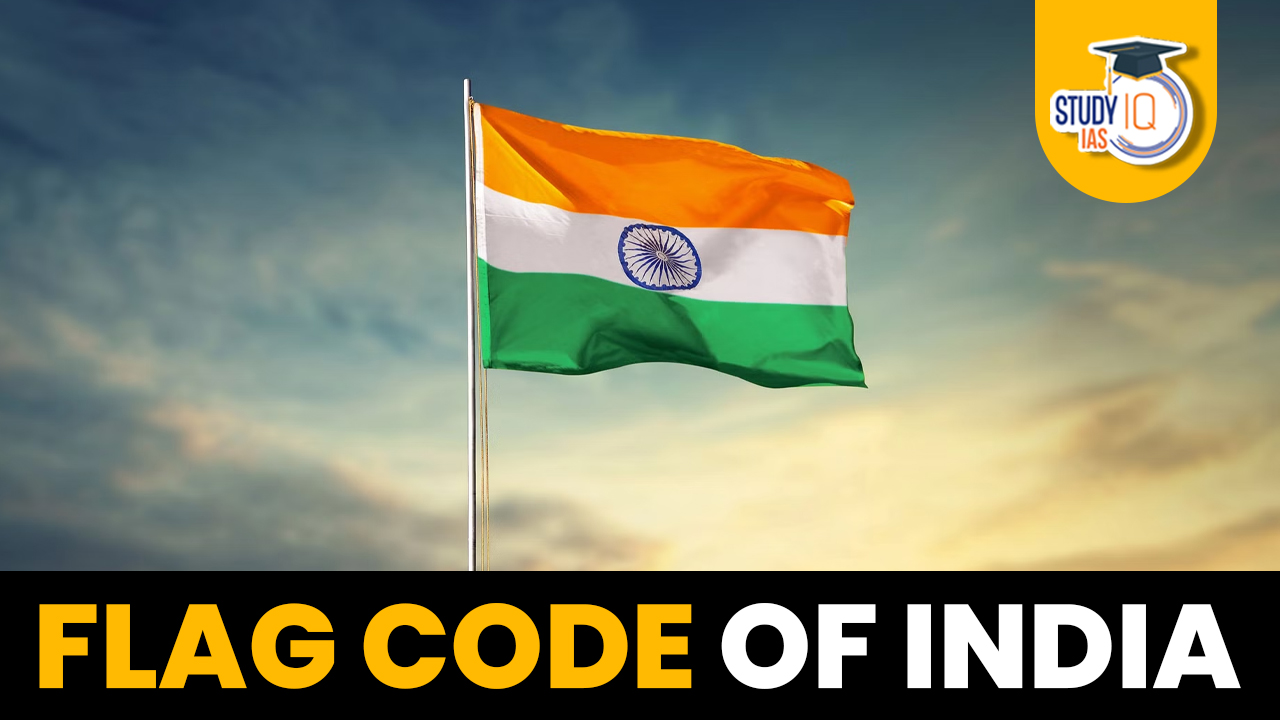Table of Contents
The Indian National Flag is a symbol of national pride and unity. It holds immense significance in the history and culture of India. Here’s a detailed breakdown related to the Flag Code of India 2002, its amendments, the design of the Indian flag, and key details related to the national flag.
Flag Code of India 2002
The Indian National Flag represents the hopes and aspirations of the people of India. It symbolises our national pride and universal affection and respect for, and loyalty to, the National Flag. It occupies a unique and special place in the emotions and psyche of the people of India. The Flag Code of India is the set of rules and regulations, practices and guidelines that apply to the display of the national flag of India. The Flag Code for India 2002 is classified into three sections:
- National Flag general description
- Display of National Flag by Institutions such as Educational, Public, Private etc.
- Display of National Flag by Central Government as well as State Governments and their agencies as well.
Who Designed Indian National Flag?
The Indian National Flag was designed by Pingali Venkayya, a freedom fighter and a Gandhian. He presented the design to Mahatma Gandhi, and it was adopted in its present form during the Constituent Assembly meeting on July 22, 1947.
Flag Hoisting on 78th Independence Day 2024
India will celebrate its 78th Independence Day on August 15, 2024. The Prime Minister of India will hoist the national flag at the Red Fort, New Delhi. Traditionally, flag hoisting ceremonies will be held across the country in government offices, educational institutions, and public spaces to honor the nation’s freedom.
National Flag of India
The national flag, commonly known as the “Tricolour” (Tiranga), has three horizontal stripes of different colors. Each color has a symbolic meaning:
- Saffron (Top): Represents courage and sacrifice.
- White (Middle): Denotes peace and truth. The white stripe contains the Ashoka Chakra (wheel) in navy blue, which has 24 spokes.
- Green (Bottom): Stands for faith, fertility, and the land.
The flag has a 3:2 width-to-length ratio, and the Ashoka Chakra represents the eternal wheel of law.
Flag Hoisting Time
As per tradition, the flag hoisting on Independence Day is done at sunrise. However, since the recent amendments, the flag can now be hoisted anytime during the day or night, provided it is displayed with respect.
Tricolour Symbolism
The Indian tricolour symbolizes the strength, unity, and history of the nation. The colors embody the essence of the country’s values:
- Saffron: Reflects the strength and courage of the country.
- White: Symbolizes peace and truth, aligning with Gandhi’s ideals.
- Green: Represents the fertility, growth, and prosperity of the land.
History of Indian Flag Code
The history of Indian Flag Code is closely tied to the evolution of the national flag itself and the principles of respect and honour associated with it. Initially, the Emblems and Names (Prevention of Improper Use) Act, of 1950 as well as the Prevention of Insults to National Honour Act, of 1971 governed the display of the National Flag in India. As an attempt to bring both the above-mentioned law together, the Flag Code of India 2002 was framed. Advocate B. M. Birajdar said, “The Flag Code of India 2002 permits the unrestricted display of the tricolour, consistent with the honour and dignity of the flag,”. Here is a brief overview of the history of the Indian Flag Code:
| Year/Date | Event/Development |
|---|---|
| 1906 | First unofficial Indian flag was hoisted on August 7, 1906, in Calcutta (now Kolkata) with three horizontal stripes of green, yellow, and red. |
| 1921 | Pingali Venkayya presented a design of the national flag to Mahatma Gandhi at the Indian National Congress session, which was later modified. |
| 1931 | The Indian National Congress adopted the Tricolour as its official flag, with saffron, white, and green stripes and the spinning wheel (Charkha) in the centre. |
| 1947 | Constituent Assembly of India adopted the current version of the Indian national flag on July 22, 1947. The Ashoka Chakra replaced the spinning wheel. |
| 1950 | Emblems and Names (Prevention of Improper Use) Act, 1950 enacted to prevent improper use of the national flag and other national symbols. |
| 1971 | Prevention of Insults to National Honour Act, 1971 enacted to prohibit disrespect to the national flag and the Constitution of India. |
| 1995 | Naveen Jindal’s Legal Battle: Naveen Jindal, an industrialist, filed a petition challenging restrictions on flag hoisting by citizens. |
| 2002 | Flag Code of India, 2002 introduced on January 26, 2002. It allowed Indian citizens to hoist the national flag at their homes, ending years of legal restrictions. |
| 2021 (December) | The amendment allowed machine-made polyester flags. Previously, only hand-spun and handwoven flags were allowed. |
| 2022 (July) | The amendment allowed the national flag to be hoisted day and night at private homes, public places, and institutions, provided it was displayed with dignity. |
Origins of the Indian National Flag
The design of the Indian national flag was adopted by the Constituent Assembly of India on July 22, 1947, shortly before India gained independence from British colonial rule. The flag features three horizontal stripes of saffron (top), white (middle), and green (bottom), with a blue Ashoka Chakra (wheel) with 24 spokes in the centre of the white stripe. The colours and symbols of the flag hold significant meaning, representing various aspects of India’s heritage and culture, and aspirations.
Dimension of Indian National Flag

Dimension of Ashoka Chakra

Flag Code of India 2002 and 2022 Amendment
The hoisting/use/display of the Indian National Flag is governed by the Prevention of Insults to National Honour Act, 1971 and the Flag Code of India 2002. Some of the salient features of the Flag Code of India 2002 are listed below for the information of the public:
- The Flag Code of India, 2002 was amended vide Order dated 30th December 2021 and a National Flag made of polyester or machine-made Flag has been allowed. Now, the National Flag shall be made of hand-spun and hand-woven or machine-made, cotton/polyester/wool/silk khadi bunting.
- A member of a public, a private organization or an educational institution may hoist/display the National Flag on all days and occasions, ceremonial or otherwise, consistent with the dignity and honour of the National Flag.
- Flag Code of India Amendment 2022: The Flag Code of India, 2002 was amended vide Order dated 19th July 2022 and clause (xi) of paragraph 2.2 of Part-Il of the Flag Code of India was replaced by the following clause “where the Flag is displayed in open or displayed on the house of a member of the public, it may be flown day and night;”
- The National Flag shall be rectangular in shape. The Flag can be of any size but the ratio of the length to the height (width) of the Flag shall be 3:2.
- Whenever the National Flag is displayed, it should occupy the position of honour and should be distinctly placed.
- A damaged or dishevelled Flag shall not be displayed.
- The Flag should not be flown from a single masthead simultaneously with any other flag or flags.
- The Flag should not be flown on any vehicle except the dignitaries mentioned in Section IX of Part Ill of the Flag Code, such as the President, Vice-President, Prime-Minister, Governors etc.
- No other flag or bunting should be placed higher than or above or side by side with the National Flag.
Recent Changes on Flag Code of India 2002
| Date | Change/Amendment | Details |
|---|---|---|
| December 30, 2021 | Use of Machine-Made Polyester Flags | An amendment was made allowing the use of machine-made polyester flags in addition to hand-spun and handwoven cotton, wool, silk, or khadi flags. |
| July 20, 2022 | Day and Night Hoisting of Flags | Another amendment permitted the national flag to be hoisted day and night at private homes, public places, and institutions, provided it is displayed with dignity. |
| 2022 (General Update) | Flexibility in Flag Display | The government allowed citizens to display the flag on all occasions, formal or informal, not just national holidays, expanding the flexibility of usage. |


 Daily Quiz 16 April 2025
Daily Quiz 16 April 2025
 Bhashanet Portal : Empowering Multilingu...
Bhashanet Portal : Empowering Multilingu...
 Soyuz Aircraft: History, Design and Sign...
Soyuz Aircraft: History, Design and Sign...





















